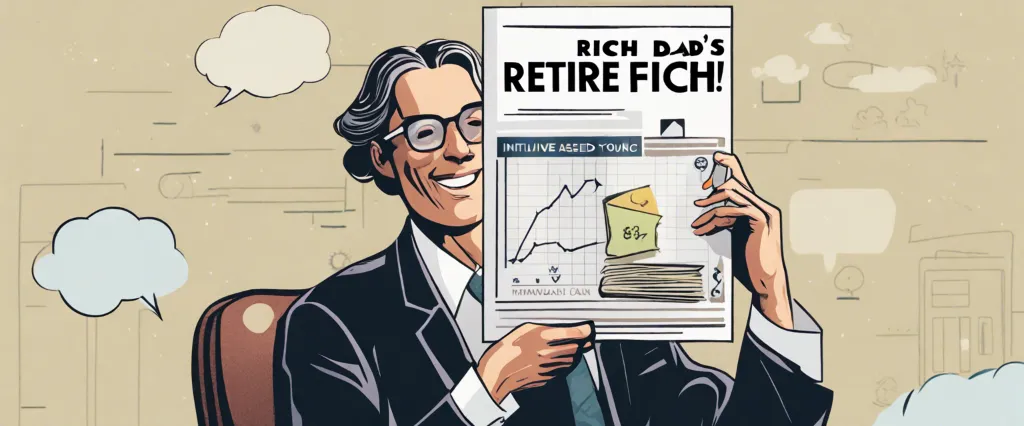In “Rich Dad’s Retire Young, Retire Rich,” renowned author and entrepreneur Robert T. Kiyosaki delves into the secrets of achieving financial independence and retiring early. Drawing upon his own experiences and the wisdom imparted by his influential “rich dad,” Kiyosaki provides invaluable insights, strategies, and mindset shifts necessary to retire young and live a life of abundance. With his proven track record of success and entrepreneurial expertise, Kiyosaki continues to inspire readers worldwide to break free from the traditional “rat race” and embrace the path to financial freedom.
Chapter 1: The Mindset of the Rich
In Chapter 1 of “Rich Dad’s Retire Young, Retire Rich” by Robert T. Kiyosaki, the author discusses the mindset of the rich and introduces several key concepts that can help individuals achieve financial independence and retire early.
Kiyosaki starts by highlighting the importance of having a different mindset from the majority of people when it comes to money. He contrasts the mindsets of the rich and the poor, emphasizing that the poor tend to focus on job security, a steady paycheck, and the need to work for money, while the rich focus on creating assets, generating passive income, and making money work for them.
The author introduces the concept of the “CASHFLOW Quadrant,” which outlines four different ways people make money: being an employee (E), self-employed (S), a business owner (B), or an investor (I). He explains that the rich prioritize being on the right side of the quadrant (B and I), where they can leverage their time and money to create wealth. Kiyosaki also notes that most people are conditioned to study and work within the E and S quadrants, which limits their financial potential.
Furthermore, Kiyosaki emphasizes the importance of financial education and lifelong learning. He advises individuals to continuously invest in expanding their knowledge and to surround themselves with like-minded people who are also looking to achieve financial freedom.
Finally, the author encourages readers to develop a strong desire to be financially independent and retire young. He argues that achieving financial independence is not only about money but also about freedom, security, and the ability to do what one truly loves.
Overall, Chapter 1 establishes the foundation for the book by introducing the mindset of the rich, highlighting the importance of financial education, and inspiring readers to pursue their own path to early retirement and financial freedom.
Chapter 2: Understanding Assets and Liabilities
Chapter 2 of “Rich Dad’s Retire Young, Retire Rich” by Robert T. Kiyosaki delves into the fundamental concepts of assets and liabilities, highlighting their importance in achieving financial independence and retiring early. Kiyosaki emphasizes the differences between how the rich and the middle class view and handle assets and liabilities.
The author begins by explaining that most people have a misunderstanding of what an asset truly is. While many consider their house or car as assets, Kiyosaki argues that these are actually liabilities since they consume money rather than generate it. He defines an asset as something that puts money into an individual’s pocket, such as businesses, investments, or real estate that generate passive income.
Additionally, Kiyosaki introduces the concept of cash flow, which is the lifeblood of true assets. Cash flow refers to the continuous stream of income generated by assets that allows individuals to achieve financial freedom. The author emphasizes the importance of increasing one’s cash flow through acquiring more assets that generate passive income, rather than solely relying on earned income from a job.
Kiyosaki compares the differences in financial education between the rich and the middle class, asserting that the rich understand how to leverage and grow their assets, while the middle class tends to accumulate liabilities that hold them back financially. He urges readers to shift their mindset, embrace financial education, and take control of their financial future by focusing on acquiring and growing assets that generate passive income.
In summary, Chapter 2 of “Rich Dad’s Retire Young, Retire Rich” provides a fundamental understanding of assets and liabilities. Kiyosaki stresses the importance of distinguishing between true assets that generate income and liabilities that consume it. By focusing on increasing cash flow through acquiring and leveraging assets, individuals can break free from the cycle of financial dependence and work towards early retirement.
Chapter 3: Building Financial Intelligence
Chapter 3 of “Rich Dad’s Retire Young, Retire Rich” by Robert T. Kiyosaki focuses on the importance of building financial intelligence. Kiyosaki emphasizes that financial intelligence is the foundation for building wealth and achieving financial security in retirement.
According to Kiyosaki, most people lack financial intelligence because it is not taught in schools. He believes that traditional education focuses more on academic intelligence rather than financial knowledge, resulting in many individuals struggling with money management and financial decisions throughout their lives.
To build financial intelligence, Kiyosaki suggests learning how to read and understand financial statements. He explains that financial statements are like the “scorecards” of a business, providing crucial information about its profitability, assets, liabilities, and cash flow. Understanding financial statements enables individuals to assess the financial health of a business before investing or making financial decisions.
Kiyosaki also emphasizes the importance of developing a solid understanding of accounting principles. He argues that by understanding key accounting terms and concepts, individuals can better navigate the financial world and make informed decisions.
Another aspect of financial intelligence discussed in the chapter is the ability to differentiate between good and bad debt. Kiyosaki explains that good debt is debt used to acquire assets that generate income and appreciate in value, while bad debt is debt used to purchase liabilities that do not bring in income or increase in value. Building financial intelligence enables individuals to distinguish between the two and make wise borrowing decisions.
In summary, Chapter 3 of “Rich Dad’s Retire Young, Retire Rich” emphasizes the significance of building financial intelligence. It encourages readers to educate themselves on financial statements, accounting principles, and the difference between good and bad debt to enhance their financial knowledge and make sound financial decisions.
Chapter 4: Investing in Real Estate

Chapter 4: Investing in Real Estate of “Rich Dad’s Retire Young, Retire Rich” by Robert T. Kiyosaki introduces the concept of real estate investing as a tool for creating passive income and achieving financial freedom. Kiyosaki emphasizes that investing in real estate is not just about buying and selling properties but understanding the fundamental principles behind it.
The chapter begins by explaining how most people have been conditioned to believe that their home is an asset, when in reality, it is a liability as it generates expenses rather than income. Kiyosaki urges readers to shift their mindset and start investing in income-generating real estate properties that offer cash flow.
Kiyosaki highlights the importance of financial education and emphasizes that real estate investing is a business that requires knowledge, understanding of market trends, and careful analysis. He advises readers to educate themselves on topics such as property valuation, market cycles, and financing options.
The chapter also delves into different types of real estate investments, such as residential properties, commercial properties, and paper assets, including Real Estate Investment Trusts (REITs) and mortgage-backed securities. Kiyosaki emphasizes the need to diversify investments across various real estate sectors rather than focusing on a single type.
Furthermore, Kiyosaki introduces the concept of leverage in real estate investing, where one can use other people’s money (OPM) to fund their investments. He explains how investors can take advantage of favorable financing options, such as mortgages, to maximize returns while minimizing personal financial risk.
In summary, Chapter 4 emphasizes the importance of real estate investing as a means to create passive income and financial freedom. It provides an overview of key principles, encourages readers to expand their financial knowledge, diversify their investments, and leverage other people’s money to build a successful real estate portfolio.
Chapter 5: Entrepreneurship and Investment
Chapter 5 of “Rich Dad’s Retire Young, Retire Rich” by Robert T. Kiyosaki focuses on the importance of entrepreneurship and investment in achieving financial independence and retiring young.
Kiyosaki begins by highlighting the traditional path most people take towards retirement, which involves depending on a stable job and saving for the future. However, he argues that this approach is flawed because it relies on factors beyond individual control, such as job security and the performance of the stock market.
To counter this, Kiyosaki emphasizes the need to become an entrepreneur and investor. He explains that entrepreneurs are driven by their desire to solve problems and create value, which in turn leads to financial success. They take risks, think outside the box, and constantly innovate. By becoming an entrepreneur, individuals have more control over their income and can choose to retire young when they reach financial independence.
The chapter also highlights the importance of investing. Kiyosaki breaks down the different types of investments, including stocks, real estate, and businesses. He advises readers to educate themselves about each type and to diversify their investments to reduce risk. By investing in income-generating assets, individuals can create passive income streams and build wealth over time.
Kiyosaki emphasizes that entrepreneurship and investment are not quick-fix solutions but long-term strategies that require continuous learning and adaptation. He encourages readers to shift their mindset from being employees to becoming actively engaged in entrepreneurship and investment opportunities. By doing so, individuals can increase their financial intelligence and move towards a life of financial freedom and early retirement.
In summary, Chapter 5 delves into the importance of entrepreneurship and investment in achieving financial independence and retiring young. It promotes the idea of taking control of one’s financial future by becoming an entrepreneur, investing wisely, and continuously evolving through learning and adapting to market trends.
Chapter 6: The Path to Financial Freedom
In Chapter 6: The Path to Financial Freedom of “Rich Dad’s Retire Young, Retire Rich” by Robert T. Kiyosaki, the author emphasizes the importance of creating a clear path to financial freedom. He starts by highlighting the business world’s changing landscape, where traditional job security is diminishing, and people need to take control of their financial future.
Kiyosaki discusses how most people work for money and are trapped in the rat race, constantly struggling to make ends meet. To break free, he suggests adopting an investor mindset and focusing on building assets that generate passive income. He explains that investing in stocks, bonds, and mutual funds alone is not enough. To retire rich and young, individuals need to build their own business or investment empire.
The author outlines the three essential steps to financial freedom. Firstly, one must invest in their financial education and continuously expand their knowledge of investing. By understanding different investment strategies and financial markets, individuals can make informed decisions and maximize their returns. Secondly, Kiyosaki emphasizes the importance of taking action and not just accumulating knowledge. Fear and self-doubt often hold people back, but to achieve financial freedom, they must take calculated risks and overcome these barriers. Lastly, he advises individuals to persist and never give up. Building financial wealth takes time and dedication, but by staying focused and learning from failures, success can be achieved.
Moreover, Kiyosaki emphasizes the significance of developing a team of experts, such as accountants, attorneys, and financial advisors, to navigate through the complex world of investments and taxation. These professionals play a crucial role in protecting and growing one’s wealth.
Overall, Chapter 6 emphasizes the need to change one’s mindset, acquire financial education, take action, persist, and build a strong team to achieve financial freedom. It serves as a guide to developing a clear path towards early retirement and attaining true financial independence.
Chapter 7: Developing Rich Habits
Chapter 7: Developing Rich Habits of the book “Rich Dad’s Retire Young, Retire Rich” by Robert T. Kiyosaki focuses on cultivating the habits necessary to build wealth and achieve financial independence. Kiyosaki emphasizes that becoming rich is not just about making money, but also about developing a mindset and adopting specific habits that contribute to long-term success.
The chapter begins by discussing the power of goals and the need to have a clear vision of what one wants to achieve financially. Kiyosaki stresses the importance of setting specific and measurable goals, as they provide direction and motivation.
Next, he highlights the significance of education and continuous learning. Kiyosaki encourages readers to invest in their education and gain financial intelligence, as it plays a pivotal role in making wise investment decisions and taking calculated risks.
Furthermore, the chapter emphasizes the value of discipline and consistency. Kiyosaki stresses the need to develop good habits, such as budgeting, saving, and investing regularly. He explains that these habits create a strong financial foundation and contribute to long-term wealth accumulation.
Kiyosaki also emphasizes the importance of taking action and being proactive. He urges readers to overcome fear and take calculated risks, as well as to learn from failures and make adjustments along the way.
The chapter concludes by highlighting the significance of perseverance and resilience in the face of challenges. Kiyosaki encourages readers to keep pushing forward, learning from their mistakes, and remaining focused on their goals.
In summary, Chapter 7 of “Rich Dad’s Retire Young, Retire Rich” underscores the importance of developing rich habits, including goal setting, continuous learning, discipline, action-taking, and perseverance. These habits, when adopted and practiced consistently, contribute to financial success and ultimately pave the way for a secure and fulfilling retirement.

Chapter 8: Retire Young, Retire Rich
Chapter 8 of Rich Dad’s Retire Young, Retire Rich by Robert T. Kiyosaki focuses on the importance of building a business and the role it plays in achieving early retirement and financial independence.
Kiyosaki begins by emphasizing the difference between being an employee and being an entrepreneur. He argues that employees work for money, while entrepreneurs make money work for them. He suggests that relying solely on a job or investing in traditional retirement plans is not enough to retire young and retire rich. Instead, he advocates for creating a system or business that generates passive income.
The author discusses the concept of generating passive income, which refers to making money without physically trading time for it. He argues that building a successful business that generates passive income is key to achieving early retirement. Kiyosaki emphasizes the importance of not just creating any business, but a business that solves problems or provides value to customers. This ensures long-term success and financial stability.
Furthermore, the author talks about the mindset and skills required to become a successful entrepreneur. He stresses the need for financial education, emphasizing that knowledge about money and investing is essential to building a thriving business. Kiyosaki also emphasizes the importance of continuously learning and adapting to the changing marketplace in order to stay ahead.
In conclusion, Chapter 8 of Rich Dad’s Retire Young, Retire Rich emphasizes the significance of building a business that generates passive income. Kiyosaki advocates for developing the entrepreneurial mindset, acquiring financial education, and continuously adapting to succeed as an entrepreneur. By doing so, individuals can retire young and retire rich by creating a reliable source of income independent of working a traditional job or relying solely on retirement plans.
After Reading
In “Rich Dad’s Retire Young, Retire Rich,” Robert T. Kiyosaki emphasizes the importance of adopting a different mindset and changing one’s approach to money in order to retire young and retire rich. Through his personal experiences and the guidance of his rich dad, Kiyosaki highlights the significance of financial education, investing wisely, and taking calculated risks. He encourages readers to break free from the traditional path of working for money and instead focus on building assets and creating passive income sources. Kiyosaki stresses the value of continuously expanding one’s financial intelligence and acquiring assets that generate cash flow, ultimately providing financial freedom and the ability to retire young and rich.
1. “The Automatic Millionaire: A Powerful One-Step Plan to Live and Finish Rich” by David Bach
– Similar to Kiyosaki’s book, this guide provides practical steps and strategies to achieve financial independence and retire early. It focuses on automating your savings and investments to build wealth over time.
2. The Four Hour Work Week: Escape the 9-5, Live Anywhere, and Join the New Rich” by Timothy Ferriss
– This book challenges traditional notions of retirement by advocating for a lifestyle design that allows one to work less and enjoy life more. Ferriss shares his personal experiences and offers insights into creating a sustainable income while reducing time spent working.
3. “Your Money or Your Life: 9 Steps to Transforming Your Relationship with Money and Achieving Financial Independence” by Vicki Robin and Joe Dominguez
– With a focus on financial independence, this book explores the idea of aligning your values and priorities with your financial decisions. It provides a step-by-step process to gain control over your finances and find freedom from the constraints of traditional retirement.
4. “Early Retirement Extreme: A Philosophical and Practical Guide to Financial Independence” by Jacob Lund Fisker
– Focusing on extreme frugality and minimalism, this book delves into the concept of achieving early retirement through a radical approach to personal finance. It offers alternative perspectives on spending, saving, investing, and lifestyle choices to help readers retire early and live more intentional lives.
5. “Quit Like a Millionaire: No Gimmicks, Luck, or Trust Fund Required” by Kristy Shen and Bryce Leung
– Shen and Leung share their personal journey of how they retire by the age of 31 with a million-dollar net worth. The book provides insights into their unique investment strategies, embracing frugality, and building wealth through various income streams, making it an inspiring read for those looking to achieve financial independence.




